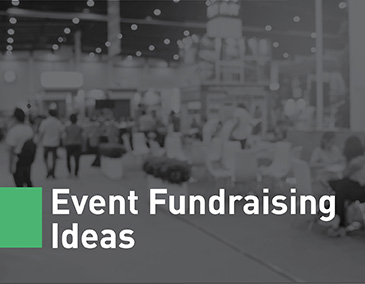Planning a Fundraiser
Think of your fundraiser like building a house. If you want to build a 3 bedroom, 3 bath colonial charmer, you might want to have a blueprint on hand. Same goes for fundraising. Write down all of your goals, objectives, and budget information. This will help give you a solid idea of what your ideas are.
Look to the Past
You shouldn’t have to look into a magical crystal ball to tell you what kind of fundraiser you should have. If you’ve done events in the past that were successful, look to them for inspiration.
Obviously don’t repeat the same fundraiser over and over again. Keep things fresh and new to encourage existing and potential donors to participate!
Keep Your Budget in Mind
There’s no reason to hold a fundraiser that ends up costing more money than it brings in. Make sure you consider all of the costs and try to account for any unforeseen expenses.
Potential costs (depending on your fundraiser) can include:
- Food and drinks
- Printed materials
- Prizes
- Advertising
- Location fees
Being aware of these and other expenses that your organization might run up against is vital in planning your fundraiser.
Target a Particular Audience
Do you want anyone from the general public to participate in your fundraiser? Do you want to grab the attention of major gift donors? Do you want to strengthen the relationships you have with existing, dedicated contributors?
Depending on which demographic you are focusing on, you will need to adjust your fundraising strategies.
If you’re trying to capture the attention of new donors, provide them with more introductory information about your organization so they know the causes you support. If you want to appeal to existing donors, give them updates on projects that their previous donations have helped fund.
Knowing your audience can be an important component of a successful fundraiser.
Brainstorm
Once you have goals and a target audience in place, it’s time to figure out what type of fundraiser you want to have. Bring in a group of your most creative staff members and start throwing out ideas! Make sure you stay focused and keep your budget in mind.
If you need inspiration, check out some of Double the Donation’s fundraising ideas lists!
- Unique fundraising ideas
- Church fundraising ideas
- School fundraising ideas
- Product fundraising ideas
With nearly 200 fundraising ideas at your disposal, your brainstorming session will lead to fundraising success!
Get the Word Out
Now that you have a smashing idea for a fundraiser, it’s time to let people know about it! Thankfully, there is no shortage of ways to raise awareness for your event.
Snail Mail Invitations
While sending out a postcard advertising your fundraiser might not seem like the most technologically advanced way to let people know about your event, it has its advantages:
- Postcards have a personal touch that electronic correspondence sometimes lacks.
- Tangible communication goes over well with older donors who prefer getting regular mail over email.
- People are more likely to remember your fundraiser is happening if they have something physical to remind them. It’s hard to stick an email to a fridge.
Snail mail will naturally cost more than sending out emails (you don’t need an envelope or a stamp for an email!), but if you properly weigh the cost against the return, they can be worth every penny!
If you have an established email list of existing donors, use it to let them know about your fundraiser.
Depending on how far away your event is, you might consider sending them a series of emails, giving them different opportunities to sign up, donate, and get more information about the fundraiser.
Important points to keep in mind:
- Designate a particular person or team of people to head up and maintain your email campaigns.
- Keep messages short and to the point. Donors don’t want to open their inbox and read an email the size of a Charles Dickens novel just to find out that they’re being asked for more money.
- Segment your emails depending on the type of donors you’re reaching out to.
- Be mindful that even though you’re using technology to get in touch, donors are people, not machines.
- Make sure that your emails are mobile responsive. More people than ever are checking their emails on their smartphones. Your emails need to be readable on desktops, tablets, and phones.
Using email as a way to get in touch with individuals can be a cost-effective and efficient way to promote your nonprofit’s fundraiser.
Phone Calls
For dedicated donors who regularly contribute to your organization, a phone call is a good way to make them feel appreciated while simultaneously letting them know about your upcoming fundraiser.
It’s important to remember to keep donors feeling valuable to your cause before asking them for more money:
- Have a genuine conversation
- Update them about the organization
- Let them know about existing and future projects
- Tell them about the fundraiser and ask if they’d like to contribute
Phone calls to donors are a great way to make them feel appreciated and to encourage continued support for your upcoming fundraiser.
The Big Day
You’ve planned and advertised for weeks or maybe even months. Now it’s time to put all of that hard work into action!
Designate and Delegate
Making sure that everyone on your team knows exactly where they should be and when they should be there will help your fundraiser go much more smoothly.
It’s likely that you’ll have a team of volunteers to help you set up your event, check guests in, and much more. Make sure that each person knows what tasks they’re responsible for and create a schedule that shows what shifts volunteers will be working.
Things are always bound to go wrong, but having a solid team assembled will minimize mistakes and “oops” moments.
Be Aware of your Team’s Limitations
Your donors aren’t mindless robots and neither is your fundraising team. Understand their capabilities and help them maximize their potential without wearing them out. You can’t make a fundraiser happen effectively with a half-dead staff.
Give Donors a Way to Give
If you plan on getting donations ahead of time, this step is somewhat irrelevant, but if you’re going to charge participants at the door or ask for donations during the event, you need a way to collect the money.
Make sure you have a functioning credit card machine so that donors don’t have to fill out tedious paperwork. If you plan on only accepting cash, make sure donors know that before showing up.
Acknowledge and Thank Past Donors
Letting previous donors know that their contributions are appreciated will encourage them to give more at your current event and other future fundraisers.
You can thank donors with:
- Formal speeches
- Banners
- Social media shout-outs
- A simple handshake
It’s also a great opportunity to tell them about the projects that their money is funding and update them on new ones.
Say Thank You
Letting donors know that you appreciate the donation they made at your (no doubt, amazing) fundraiser will make them want to continue donating to your organization. There are several ways of letting donors know you’re grateful.
Emails
If you had a wildly successful fundraiser that had high attendance, sending out thank you emails may be the most efficient way to demonstrate your gratitude.
It’s also a great opportunity to remind donors about matching gift programs that their employers may have in place. Matching gifts help donors feel like their contribution is doing more for your organization, and in some cases you’ll receive twice or even three times as many donations.
Thank You Cards
For dedicated donors, a handwritten thank you card is sometimes the best way to express how grateful you are for their donation. While you obviously can’t handwrite hundreds of cards, saving this option for donors who contribute a significant amount or who repeatedly donate to your organization can be a good option.
Gifts
Giving donors some kind of instant gratification after they donate can be a great way to say thank you. The gift doesn’t have to be anything extravagant. If donors contribute online it can be something as simple as an ebook.
Social Media Shout Out
If you have a substantial following on a social media site, use it as an opportunity to highlight your donors!
Many people enjoy the public recognition that comes with a social media shout out, and you nonprofit might gain a few followers in the process.
Obviously, don’t reveal personal information about the donor’s contribution, but you can post a status or tweet that mentions the fact that a particular supporter contributed during your fundraiser.
Using social media as a way to thank donors is a perfect solution for public recognition at virtually no cost.
Additional Fundraising Resources
Guide to Fundraising
Need some more fundraising guidance?
Take a look at Double the Donation’s fundraising resource for nonprofits!
Fundraising Ideas
Looking for amazing fundraising ideas?
We’ve collected over 83 stupendous fundraising ideas for organizations of all sizes!




















Social Media
In a world where a cute kitten video gets millions of views and posts can go viral in minutes, it’s fair to assume that nearly everyone uses social media in one form or another.
Finding out where your donors are posting, uploading, and liking will help you know where to spread the message about your fundraiser.
People are more likely to trust information and recommendations that are made by friends and family members over other forms of advertising.
Utilizing the more social-media conscious members of your team and donor base to spread the word can help you get your fundraiser’s details in front of more people.